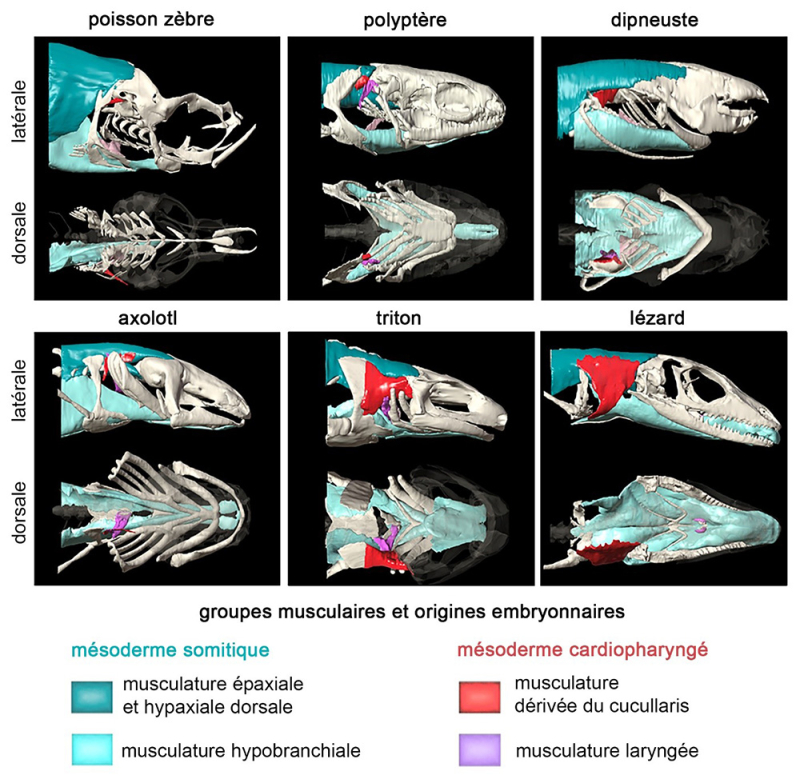Follow us on Google News (click on ☆)

Lateral and dorsal views of three-dimensional renderings from high-resolution X-ray scans of zebrafish, bichir, lungfish, axolotl, newt, and lizard. The reconstructions show the anterior skeleton of the specimens as well as the muscle groups connecting the head to the rest of the body, which have an embryonic origin either from the somitic mesoderm (dark blue, light blue) or the cardiopharyngeal mesoderm (red, purple).
© Eglantine Heude
In an article published in Nature Communications, biologists studied the embryonic origin of neck muscles and demonstrated that muscle groups connecting the head to the rest of the body in fish were repurposed to form the neck by acquiring new functions adapted to life on land.
The evolution of the neck in vertebrates: a key innovation for conquering terrestrial environments
Vertebrates (animals with vertebrae) constitute a large group of animals including fish, amphibians, reptiles, birds, and mammals. A remarkable stage in their evolution was the transition from aquatic to terrestrial life around 350 million years ago.
This major evolution was enabled by the emergence of anatomical innovations, such as limbs and the cervical region, specific to tetrapods (four-limbed vertebrates). The neck, absent in fish, allows for the mobility of the head independent of the body on land and contains structures essential for aerial respiration, feeding, or vocalization.
The acquisition of a functional neck during evolution required profound developmental rearrangements of the musculoskeletal system from the embryonic stage.
In vertebrates, it is described that the muscles of the head and trunk have distinct embryonic and genetic origins. The mesoderm is one of the three germ layers that form during embryonic development. The muscles of the head arise from the cardiopharyngeal mesoderm, which forms in the anterior region of the embryo, while the muscles of the trunk form from the somitic mesoderm. The neck constitutes a transitional zone at the head/trunk interface with a mixed embryonic origin, featuring muscles derived from both the cardiopharyngeal and somitic mesoderm.
Although the embryonic origin of these muscular structures was well established, the evolutionary origin of the neck remained to be elucidated.
Embryonic and evolutionary origin of the neck: between cardiopharyngeal and somitic mesoderm
In this study, published in the journal Nature Communications, scientists compared the mesodermal origin of muscle groups connecting the head and trunk in zebrafish and mouse embryos. Using genetic tracing approaches, they demonstrated that these muscle groups had conserved mesodermal origins and were homologous between fish and tetrapods.
The scientists then evaluated the relative contributions of the two mesodermal populations to the emergence and adaptation of the neck. To do this, they compared the musculoskeletal anatomy of several strategic extant species, including lungfish (bichir, lungfish), salamanders (axolotl, newt), and the lizard, using high-resolution X-ray scans (tomography).
For each of these species, they manually segmented and reconstructed in three dimensions the skeletal structures and muscle groups connecting the head to the trunk, derived from the somitic or cardiopharyngeal mesoderm based on data collected from the embryo.
This study provides insights into the developmental mechanisms that may have been at the origin of neck evolution in vertebrates. The analysis reveals that the cervical region evolved from muscle groups already present in fish. The results indicate that the opposing expansions of the somitic and cardiopharyngeal mesoderm, respectively in the head and trunk domains during embryonic development, contributed to the emergence and adaptation of the tetrapod neck.
The study suggests that muscle groups in ancestral fish were repurposed (co-opted) and modified to acquire new functions for respiration, feeding, and vocalization adapted to aerial life. The appearance of a functional neck likely facilitated the adaptation of early tetrapods to terrestrial environments, ensuring their evolutionary success.